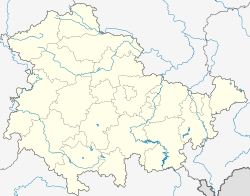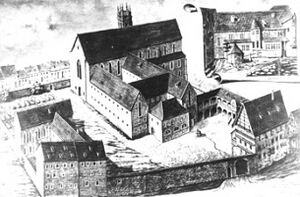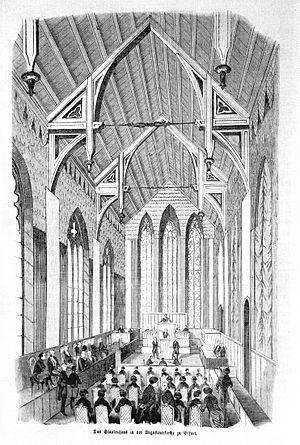St. Augustine's Monastery (Erfurt) facts for kids
| Augustinerkloster | |
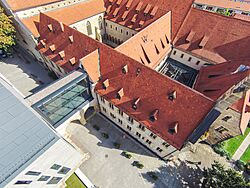 |
|
| Monastery information | |
|---|---|
| Order | Augustinians |
| Denomination | Lutheran previously Catholic |
| Established | 13th century |
| Controlled churches | Augustinerkirche |
| People | |
| Important associated figures |
|
| Architecture | |
| Status | Priory |
| Heritage designation | Kulturdenkmal in Thuringia |
| Site | |
| Location | Erfurt, |
| Country | |
| Coordinates | 50°58′53.25″N 11°1′48.02″E / 50.9814583°N 11.0300056°E |
| Website | augustinerkloster.de |
The St. Augustine's Monastery (German: Augustinerkloster) in Erfurt, Germany, is an old church and monastery complex. It was built in the 13th century by Augustinian friars, who were a group of monks from the Catholic Church.
This place is famous because Martin Luther (1483–1546) lived here. He was a friar from 1505 to 1511. Martin Luther later became known as the father of the Reformation, a big change in Christian history.
At its busiest, in the early 1500s, about 74 priests and 70 other brothers lived at the monastery. After the Reformation, the church became a Lutheran church in 1525. The city of Erfurt took over the property in 1556. It was later used for other things, but became a church again in 1854. Today, it belongs to the Evangelical Church in Central Germany.
Sadly, parts of the monastery were destroyed in a British air raid in 1945. Many people hiding there, 267 in total, died. Today, the complex has a mix of old medieval and newer buildings. It is used as a church, a meeting place, and a conference center. They also hold music concerts in the church, which has a special organ. You can even stay there for a night or for quiet retreats.
In 2016, St. Augustine's Monastery and 11 other places applied to become a World Heritage Site by UNESCO. These sites are important because they played a big part in the Reformation. This event changed religious and political history around the world.
Contents
History of the Monastery
Building the Monastery
Augustinian friars first came to Erfurt in 1266. After some disagreements, they left for a short time but came back for good in 1276. Building the church and monastery started in 1277. It was paid for by gifts and by selling indulgences. (Indulgences were like special passes that people bought from the church to reduce punishment for sins.)
More buildings were added over time. These included St. Katherine's chapel, the chapter house (a meeting room), the church tower, and a cloister (a covered walkway). Beautiful stained glass windows were put in the church between 1310 and 1340.
In 1482, two "Woad houses" were built. One stored grain, and the other was used to process the woad plant. Woad was used to make a valuable blue dye. Erfurt was famous for this dye in the Middle Ages. The friars used the money from trading woad to help support themselves.
The monastery also had a famous Studium generale, which was like an early university. It was led by Henry of Friemar the Elder, a smart Augustinian friar. The monastery's library building was constructed between 1506 and 1518.
Martin Luther's Time
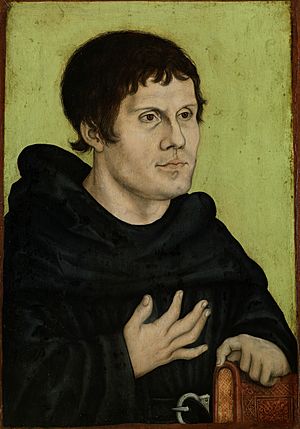
Martin Luther started studying at the University of Erfurt in 1501 when he was 17. He studied law and philosophy. A big event changed his life on July 2, 1505. He was going back to university after visiting his parents. A huge thunderstorm hit, and lightning struck nearby. He was so scared he cried out, "Help me, St. Anne, and I will become a monk!" He survived and kept his promise. He left university right away and joined St. Augustine's Monastery as a new friar on July 17, 1505.
On April 3, 1507, Luther became a priest in Erfurt Cathedral. He held his first church service on May 2, 1507, in St. Augustine's Church. In September 1508, Luther went to teach and study at Wittenberg University. He came back to St. Augustine's in September 1509. In November 1510, Luther and another friar walked over 1300 kilometers (about 800 miles) to Rome. They arrived in early December and returned to St. Augustine's in March 1511. In September 1511, Luther left the monastery for good to teach in Wittenberg.
Later, as a leader for monasteries in Saxony and Thuringia, Luther still visited St. Augustine's. On April 7, 1521, he gave an important sermon in St. Augustine's Church. He spoke against some of the Catholic Church's ideas. This was on his way to the Diet of Worms, a big meeting where he had to explain his teachings. He was later declared a heretic, meaning someone whose beliefs go against official church teachings.
The Luther Cell
Today, you can see a room called the 'Luther Cell'. It's a rebuilt version of what people think was Luther's room after he came back from Rome. After he died in 1546, this room became a special place that many people visited. A fire in 1872 damaged the inside of the building where the cell was. But it was rebuilt to look like it did before.
The cell was also damaged during World War II bombing. It wasn't fixed until after the war. By then, water leaks had caused more damage. So, it was taken apart and rebuilt, and the window was made smaller.
The Reformation and Beyond
From 1516 to 1522, the head of the monastery was Johannes Lang. He worked closely with Luther and helped bring the Reformation to Erfurt. He shared Luther's writings and ideas. The city council supported the Reformation, and Erfurt quickly became Protestant. In 1522, Lang and many friars left the Augustinian Order. In 1525, St. Augustine's Church became a Lutheran-Protestant church. The last friar died in 1556, and the monastery became property of the city of Erfurt.
From 1561, part of the monastery was used as a school until 1820. The friars' sleeping area was turned into rooms for students. The monastery's library lost some books during the Reformation. But in 1646, the Lutheran Library of the Evangelical Ministry moved into the building. A Protestant orphanage also used part of the monastery from 1669. In the mid-1600s, Augustinian friars came back to Erfurt, but they lived in a different place. That monastery closed in 1822.
Changes in the 1800s
The newer priory building, which was from the 14th century, was torn down in 1821. It was falling apart, and there was no money to fix it. From this time, the western part of the monastery, along with the old priory, library, and woad houses, were used by the St. Martin's foundation. This was a charity that helped educate orphans and children who needed care.
Between 1840 and 1846, the western part of the monastery and the priory were repaired. The architect Karl Friedrich Schinkel helped connect the west wing and the library. The repairs were done bit by bit. St. Augustine's Church itself had to close in 1844 because it was in bad shape. They asked King Frederick William IV of Prussia, who was a Lutheran, for money to fix the church. In 1848, it was rebuilt in a new style called neo-gothic.
From March 20 to April 29, 1850, the church was used for meetings of the parliament of the Erfurt Union. This was an attempt to unite the German states, but it didn't work out. Germany didn't unite until 1871.
The church was officially opened again in 1854. In 1872, a fire damaged the upper floor of the friars' sleeping area, but it was fixed soon after.
The 1900s and War Damage
Between 1936 and 1938, more repair work was done on the 14th-century church and part of the monastery. An architect named Theo Kellner led this work.
Near the end of World War II, on February 25, 1945, the monastery was badly damaged in a British air raid. The library and the woad houses were directly hit and destroyed. The force of the explosions blew off the roofs, windows, and doors of all the other buildings, including the church.
Luckily, the four valuable 14th-century stained glass windows from the church were saved. They had been removed and stored safely in a village church. Many valuable books from the library were also stored away for safety.
The basement of the monastery library was a public air raid shelter. Many people were hiding there during the attack. Tragically, 267 people died in the air raid, including the church pastor.
From 1946 to 1957, the church, cloister, east wing, and guesthouse (the old friars' sleeping area) were restored. In 1947, the medieval church windows were put back. The organ was fixed using spare parts from West Germany.
In 1960, a Lutheran seminary (a school for training pastors) moved to the site. It stayed there until 1993. In 1996, four sisters from an evangelical group called Communität Casteller Ring moved into rooms at the monastery. This brought the building back to a use similar to its medieval past. However, this group of sisters left Erfurt in 2011.
The Monastery Today
In November 2003, a charity called the Charitable Foundation of St. Augustine's Monastery in Erfurt was created. Its goal is to manage and pay for the repair and rebuilding of the monastery buildings. In the same year, a big restoration of the cloister was finished.
In 2003, some scenes for the movie Luther, starring Joseph Fiennes, were filmed at the monastery.
Work began in November 2006 to restore the foundations of buildings destroyed in 1945. In February 2008, they started building a new library, which cost 5 million Euros. The new building officially opened on August 27, 2010. The Library of the Evangelical Ministry, which has 60,000 books, is now housed in the monastery's old sleeping area. It's one of the most important church book collections in Germany.
In the basement of the new building, there is a "room of silence." This room remembers the 267 people who died in the air raid in February 1945. A modern "Waidhaus" (woad house) was also built on the old foundations of the medieval woad houses. It opened on September 14, 2008. It has 17 guest rooms and a space for quiet reflection in the old medieval cellar.
On September 23, 2011, Pope Benedict XVI visited the former Augustinian monastery during his trip to Germany.
In February 2016, St. Augustine's Monastery and 11 other sites applied to be added to the UNESCO World Heritage Site list as 'Luther Sites in Central Germany'. The original designation was given in 1996 to Luther sites in Eisleben and Wittenberg. A decision on the new application is still being waited for.
Gallery
See also
- Henry of Friemar the Younger


